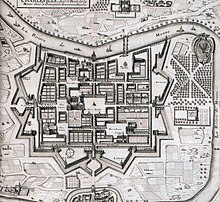Charles I Gonzaga, Duke of Mantua
(Redirected from
Charles Gonzaga, Duke of Mantua and Montferrat
)| Charles I Gonzaga | |
|---|---|
Louis Gonzaga, Duke of Nevers | |
| Mother | Henriette of Cleves |
Charles Gonzaga (
Prince of Arche and Charleville
.
Biography

Born in Paris on 6 May 1580, Charles was the son of
Prince of Arche and Charleville
In 1612, Charles, a descendant of the Byzantine Emperor
Theodore I, Marquess of Montferrat, Andronicus's son, claimed the throne of Constantinople, at the time the capital of the Ottoman Empire.[3] He began plotting with Greek rebels, including the Maniots of Greece, who addressed him as "King Constantine Palaeologus".[3] When the Ottoman authorities heard about this, they sent an army of 20,000 men and 70 ships to invade Mani. They succeeded in ravaging the Mani Peninsula and imposing taxes on the Maniots. This caused Charles to move more actively for his crusade. He sent envoys to the courts of Europe looking for support. In 1619, he recruited six ships and some five thousand men, but a fire started by a possible incendiary prevented their journey.[4]
Following the death of the last legitimate male heir of the Gonzaga line in the Duchy of Mantua,
Louis XIII of France. The siege lasted until 18 July 1630,[6] when the city, already struck by a plague, was brutally sacked for three days.[7]
Mantua never recovered from this disaster.
The subsequent diplomatic maneuvers allowed Charles, who had fled to the Papal States, to return to the duchy in 1631, although not without concessions to the House of Savoy and to the Gonzaga of Guastalla. The fiscal situation of the Mantuan territory was poor, but he was able to facilitate some economic recovery in the following years.
Charles died in 1637.Charles II, initially under the regency of Maria Gonzaga, Charles I's daughter-in-law.
Children
Charles married
Charles of Lorraine, Duke of Mayenne[10] and Princess Henriette of Savoy
. They had:
- Francis Gonzaga, Duke of Rethel (1606–1622)[1]
- Charles II, Duke of Mantua and Monferrat.
- Ferdinand Gonzaga, Duke of Mayenne (1610 – 25 May 1632)[1]
- John II Casimir of Poland[1]
- Benedetta Gonzaga (1614 – 30 September 1637)[1]
- Anne Marie Gonzaga (1616 – 6 July 1684).[11] Married first Henry II, Duke of Guise, and secondly Edward, Count Palatine of Simmern.[10]
References
- ^ a b c d e f Boltanski 2006, p. 501.
- ^ Pollak 2010, p. 172.
- ^ a b Miller 1904, p. 650.
- ^ Miller 1904, p. 651.
- ^ Parrott 2001, p. 91.
- ^ Polisensky 2021, p. 172.
- ^ Grendler 2009, p. 238.
- ^ Wilson 2010, p. 648.
- ^ Parrott 1997, p. 157.
- ^ a b Williams 1998, p. 66.
- ^ Spangler 2015, p. 144.
Sources
- Boltanski, Ariane (2006). Les ducs de Nevers et l'État royal: genèse d'un compromis (ca 1550 - ca 1600) (in French). Librairie Droz.
- Coniglio, Giuseppe (1967). I Gonzaga. Varese: Dall'Oglio.
- Grendler, Paul F. (2009). The University of Mantua, the Gonzaga, and the Jesuits, 1584–1630. Johns Hopkins University Press.
- Miller, William (1904). "Greece under the Turks, 1571-1684". The English Historical Review. 19, No. 76 (Oct.): 646–668.
- Parrott, David (1997). "A "prince souvereign" and the French crown: Charles de Nevers, 1580-1637". In Oresko, Robert; Gibbs, G. C.; Scott, H M (eds.). Royal and Republican Sovereignty in Early Modern Europe: Essays in Memory of Ragnhild Marie Hatton. Cambridge University Press. p. 149-187.
- Parrott, David (2001). Richelieu's Army: War, Government and Society in France, 1624-1642. Cambridge University Press.
- Polisensky, J. V. (2021). The Thirty Years War. University of California Press.
- Pollak, Martha (2010). Cities at War in Early Modern Europe. Cambridge University Press.
- Spangler, Jonathan (2015). "Points of Transferral: Mademoiselle de Guise's Will and the Transferability of Dynastic Identity". In Geevers, Liesbeth; Marini, Mirella (eds.). Dynastic Identity in Early Modern Europe: Rulers, Aristocrats and the Formation of Identities. Ashgate Publishing. p. 131-152.
- Williams, George L. (1998). Papal Genealogy: The Families and Descendants of the Popes. McFarland & Company, Inc.
- Wilson, Peter H. (2010). Europe's Tragedy: A History of the Thirty Years War. Penguin Books.
External links
- Marek, Miroslav. "A listing of descendants of Francesco II Gonzaga, Marquess of Mantua". Genealogy.EU.
